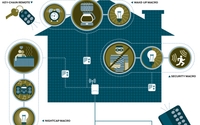 While technology around The Internet of Things proliferates,
consumers seem to be waiting for tangible and practical benefits.
While technology around The Internet of Things proliferates,
consumers seem to be waiting for tangible and practical benefits.
Even though ownership of smart home products increased in the last year, everyone is not rushing out to get the latest
connected home gadgetry.
The number of smart home products owned by consumers increased more than 50% over the last year, according to a new study by Parks Associates. Growth is projected to
continue, with 43% of U.S. households that have broadband planning to purchase a smart home device in the next 12 months.
But the drivers of those purchases are likely to be practical and
priced right.
A different study, by The Demand Institute, found that 88% of consumers see a smart home as being too expensive and only 23% said they had at least one smart device in their
home.
Pricing was also the key factor in a McKinsey study, which found that 66% of consumers rate IoT products as too expensive.
advertisement
advertisement
But cost is not the only issue. Consumers have to see a
perceived benefit.
For example, beacons have been around for around two years and they still are hardly a well-known commodity by consumers.
Even though they’ve been installed in
Apple stores for well over a year, many store employees I regularly encounter are not overly familiar with them. Apple store shoppers even less.
Only 7% of UK consumers have even heard of the
term beacon, based on a survey of 2,000 consumers by Interactive Media in Retail Group and eDigital Research.
Even worse for marketers is that almost two thirds (62%) said they don’t
want companies to be able to locate them even if just walking by a store or through a certain department. About as many (61%) viewed receiving beaconed messages as harassment, and more than half (52%)
are not comfortable with the idea of information being used to personalize offers to them.
The good news is that some retailers are starting to use beacons to trigger helpful content rather
than intrusive ads, as I wrote about here recently (Beacons Moving Well Beyond the Mobile
Ad).
And different beacon uses are being created around the world.
For example, the Real Madrid Football Club is using beacons to target fans who attend their matches with relevant
social content, a Chinese beacon company put beacons on 260 high-speed trains and beacons already are in many major retail stores around the U.S.
But it’s not about the smart object for
a home or a beacon in a store.
It’s about what value does a consumer receive from the connected technology. And what kind of a deal they can get on it.